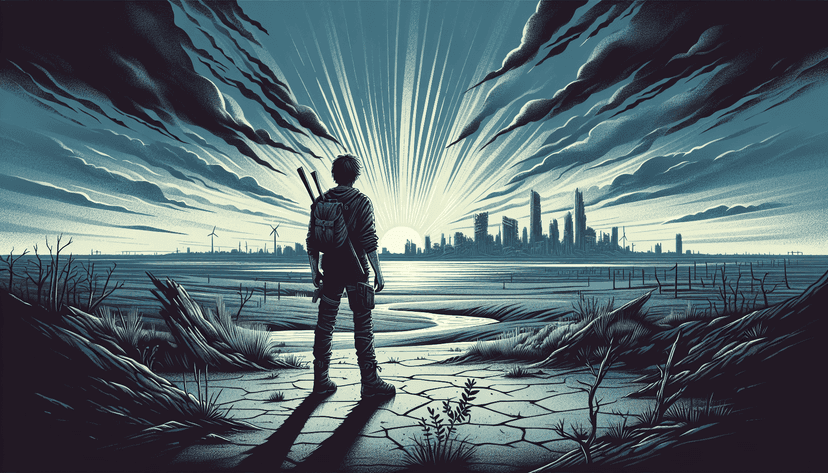Table of Contents
Writing post-apocalyptic fiction can feel daunting, right? With all the existing worlds out there, it’s tough to think of a fresh take. You might worry about making your story stand out while still pulling readers in with that gritty atmosphere we all love.
But fear not! If you stick with me, I’ll guide you through the essential steps to craft an engaging post-apocalyptic tale that’ll have your readers hanging on every word. We’ll explore everything from your protagonist’s journey to crafting a unique setting, ensuring your story isn’t just another disaster story.
Together, we’ll build a world that resonates, filled with vivid characters, thrilling challenges, and a plot that feels both coherent and exciting. Let’s dive into the nitty-gritty of post-apocalyptic storytelling!
Key Takeaways
- Start with a strong protagonist who has unique challenges and a compelling emotional journey.
- Create an immersive post-apocalyptic world that feels like a character itself.
- Define a clear cataclysmic event to ground your narrative in realism.
- Choose a strategic starting point to establish tone and tension.
- Introduce immediate dangers to hook readers from the beginning.
- Plan pacing and structure to alternate between action and introspection.
- Focus on character growth through moral dilemmas and significant choices.
- Add depth to your setting with detailed history and realistic challenges.
- Ensure plot consistency and logical progression throughout your story.
- Incorporate unique themes and elements that encourage reflection on society.

1. Start with Your Protagonist’s Journey
Begin by crafting a compelling protagonist who faces unique challenges in your post-apocalyptic landscape.
Think about their background, motivations, and what they have to lose.
For instance, if your character is a trained medic in a world ravaged by disease, their knowledge becomes critical to survival.
Explore their emotional journeys, too, because readers love to see growth and change in characters who are relatable.
2. Build Your Post-Apocalyptic World
Creating the right setting is crucial, as it’s not just a backdrop but a character itself in your story.
Your world should reflect the cataclysm—think crumbling cities, overgrown jungles, or desolate wastelands.
Consider historical contexts; for example, ancient apocalyptic literature can inspire your theme.
Don’t forget to sprinkle in the details that make your world unique, like remnants of the old civilization or quirky survivor habits.
This way, you entice readers to immerse themselves fully in your creation.
3. Define the Cataclysmic Event
The cataclysm that reshapes your world is a pivotal point in your story, so nail down the specific event that caused the apocalypse.
Whether it’s a nuclear war, a deadly virus, or a climate change disaster, your choice will deeply impact the narrative.
Use current societal issues as fuel for your ideas, as this gives your story realism and relevance.
For example, ya might consider how global pandemics have shifted reader expectations lately, making realism in such stories even more critical.

4. Choose Your Story’s Starting Point
Your story’s starting point can set the tone and introduce readers to your world.
Decide whether to kick off right before the cataclysm, during it, or well after the dust has settled.
If you start just before the event, it builds tension as readers witness normalcy collapse.
On the other hand, beginning in the aftermath can focus on survival and adaptation.
For instance, if the world has been rebuilt, characters may grapple with the scars of the past in a redefined society.
5. Introduce Danger and Challenges Early On
Dangers should come out swinging from the very beginning.
Introduce immediate threats that make your readers anxious about your characters’ fates.
This can be anything from rogue bands of survivors to mutated creatures lurking in the shadows.
Consider *Station Eleven*, where the chaos of a flu pandemic shows how fragile human existence is right away.
By establishing these challenges, you hook readers and give them a reason to root for your characters.
6. Plan Your Story’s Pacing and Structure
Your story’s pacing is critical in keeping readers engaged.
Create a flow that alternates between high-stakes action and moments of introspection.
Use cliffhangers at the ends of chapters to encourage page-turning.
Consider breaking your narrative into parts that represent significant time advancements in your world.
This structure helps track character growth and world-building in a satisfying way.
7. Focus on Character Growth and Change
Character development is essential in a post-apocalyptic narrative.
Readers connect with characters who evolve in response to their harsh worlds.
Challenge your protagonist with moral dilemmas that force them to rethink their values.
For example, they might struggle between helping a rival survivor and ensuring their own safety.
This growth often resonates with readers, especially in a genre stirring reflections on humanity’s nature.
8. Create a Realistic and Detailed Setting
Your apocalyptic setting isn’t just about desolation; it must feel lived in.
Add layers of history by incorporating remnants of civilization—crumbling buildings and rusted vehicles serve as potent reminders of what once was.
Ensure the climate and geography mirror the story’s challenges.
For instance, if survivors must traverse a desert, a scarcity of water can heighten tension.
A rich, immersive world invites readers to become emotionally invested in every detail.
9. Keep Your Plot Consistent and Logical
Maintaining continuity in a complex narrative helps build trust with readers.
Establish rules for your world and stick to them; if you introduce a technology early on, don’t conveniently forget it later.
Check your plot for holes by writing a brief outline to ensure events advance in a logical manner.
Consistency holds the narrative together, making it believable.
Audiences appreciate a tight storyline where actions have consequences, adding depth to their experience.
10. Add Unique Elements and Themes to Your Story
Your post-apocalyptic story has to stand out amidst a sea of competitors.
Consider exploring themes like resilience, morality, or the strength of community.
Infuse unique elements like an unconventional protagonist—a child or an elderly person—who offers fresh perspectives on survival.
You might take inspiration from historical apocalyptic literature, generating parallels to current societal trends.
Using these elements encourages readers to reflect on their own world through your narrative lens and keeps them talking long after the last page.
FAQs
Defining the cataclysmic event sets the stage for your world, influencing character motivations and conflicts. It provides context for the societal breakdown and can affect themes such as survival, resilience, and human nature.
To ensure character growth, create challenges that force them to confront their fears and weaknesses. Incorporate lessons learned during their journey and reveal how experiences shape their identities by the story’s conclusion.
A realistic post-apocalyptic setting should include detailed descriptions of the environment, the consequences of the cataclysm, and societal adjustments. Incorporate tangible elements like scarcity, new social structures, and survival tactics to enrich the experience.
To maintain consistency, establish rules for your world and stick to them. Keep track of character actions and consequences, ensuring they align with your defined universe. Regularly revise your plot for logical coherence.



